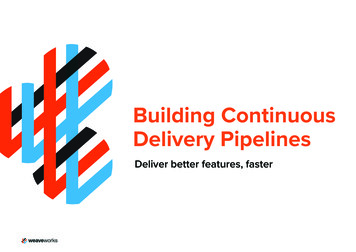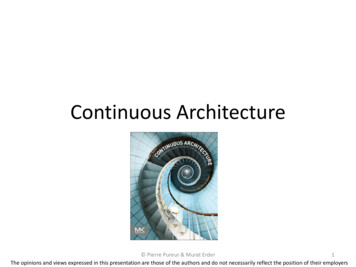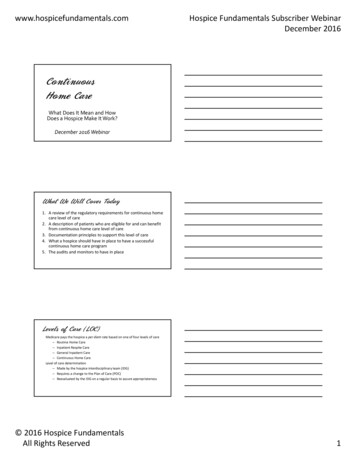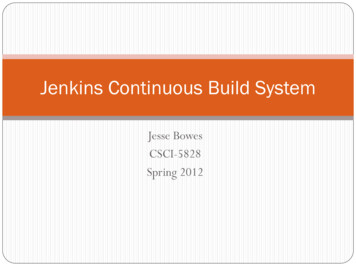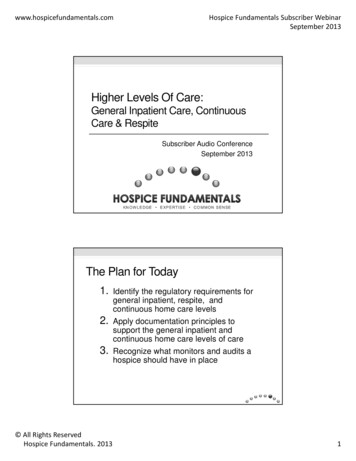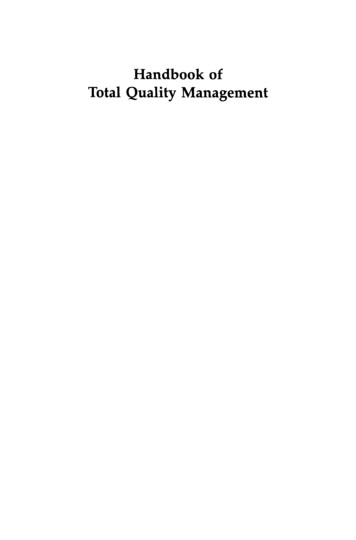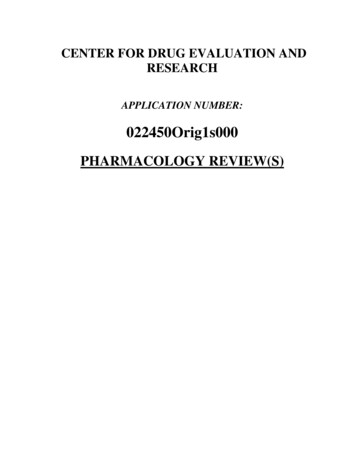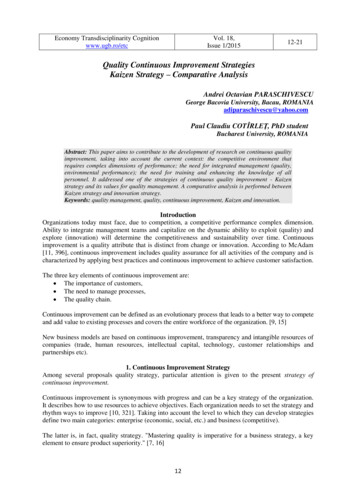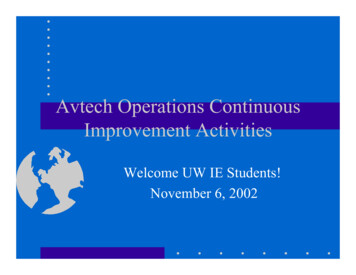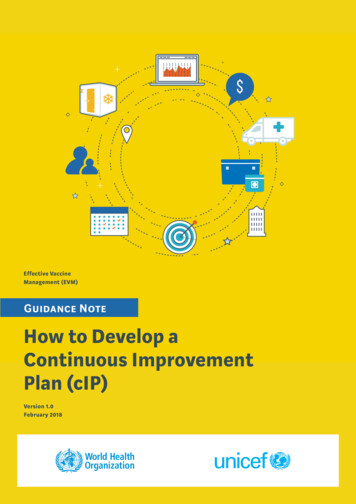
Transcription
Effective VaccineManagement (EVM)Guidance NoteHow to Develop aContinuous ImprovementPlan (cIP)Version 1.0February 2018How to Develop a Continuous Improvement Plan (cIP)1
Guidance note: how to develop a continuous improvement plan (cIP)ISBN 978-92-4-151429-3 World Health Organization and the United Nations Children’s Fund (UNICEF) 2018Some rights reserved. This work is available under the Creative Commons Attribution-NonCommercial-ShareAlike 3.0 IGO licence(CC BY-NC-SA 3.0 IGO; igo).Under the terms of this licence, you may copy, redistribute and adapt the work for non-commercial purposes, provided the workis appropriately cited, as indicated below. In any use of this work, there should be no suggestion that WHO or UNICEF endorsesany specific organization, products or services. The unauthorized use of the WHO or UNICEF names or logos is not permitted.If you adapt the work, then you must license your work under the same or equivalent Creative Commons licence. If you createa translation of this work, you should add the following disclaimer along with the suggested citation: “This translation was notcreated by the World Health Organization (WHO) or the United Nations Children’s Fund (UNICEF). Neither WHO nor UNICEF areresponsible for the content or accuracy of this translation. The original English edition shall be the binding and authentic edition”.Any mediation relating to disputes arising under the licence shall be conducted in accordance with the mediation rules of theWorld Intellectual Property Organization sted citation. Guidance note: how to develop a continuous improvement plan (cIP). Geneva: World Health Organization andthe United Nations Children’s Fund (UNICEF), 2017. Licence: CC BY-NC-SA 3.0 IGO.Cataloguing-in-Publication (CIP) data. CIP data are available at http://apps.who.int/iris.Sales, rights and licensing. To purchase WHO publications, see http://apps.who.int/bookorders. To submit requests forcommercial use and queries on rights and licensing, see http://www.who.int/about/licensing.Third-party materials. If you wish to reuse material from this work that is attributed to a third party, such as tables, figures orimages, it is your responsibility to determine whether permission is needed for that reuse and to obtain permission from thecopyright holder. The risk of claims resulting from infringement of any third-party-owned component in the work rests solely withthe user.General disclaimers. The designations employed and the presentation of the material in this publication do not imply theexpression of any opinion whatsoever on the part of WHO or UNICEF concerning the legal status of any country, territory, city orarea or of its authorities, or concerning the delimitation of its frontiers or boundaries. Dotted and dashed lines on maps representapproximate border lines for which there may not yet be full agreement.The mention of specific companies or of certain manufacturers’ products does not imply that they are endorsed or recommendedby WHO or UNICEF in preference to others of a similar nature that are not mentioned. Errors and omissions excepted, the namesof proprietary products are distinguished by initial capital letters.All reasonable precautions have been taken by WHO and UNICEF to verify the information contained in this publication. However,the published material is being distributed without warranty of any kind, either expressed or implied. The responsibility for theinterpretation and use of the material lies with the reader. In no event shall WHO or UNICEF be liable for damages arising from itsuse.Printed in Switzerland2
Contents11.1What is the Effective Vaccine Management (EVM) initiative?91.2The immunization supply chain continuous Improvement Plan (cIP)121.2.1Why develop a cIP?121.2.2Aligning EVM assessment results with the six supply chain essentials14Introduction22.1When should the cIP be developed?172.2Who is responsible for developing the cIP?182.3What is the best way to develop a cIP?192.3.1Compile and disseminate a situation analysis192.3.2Convene a cIP workshop202.3.3Align cIP goals and objectives with broader national health plans242.3.4Draft the five-year strategic cIP, including annual operational plan272.3.5Conduct a planning and budgeting exercise28The continuousImprovement Plan(cIP) developmentprocess3The continuousImprovement Plan(cIP) content4Implementing andmonitoring the cIP53.1Situation and root-cause analyses313.2The cIP strategic plan333.2.1Long-term vision for the immunization supply chain333.2.2Goals, objectives, strategies, key performance indicators, and costs343.3The cIP annual operational plan363.3.136Operational plan3.4Associated costs and sources of funding374.1Socialize and institutionalize the cIP394.2Implement the cIP404.3Monitor implementation and outcomes41Continuous learning and improvementHow to Develop a Continuous Improvement Plan (cIP)423
Supplemental resourcessupplement 1:Establishing or strengthening a National Logistics Working chain-and-logistics/3735supplement 2:Situation analysiswww.technet-21.org/en/?option com sobipro&sid 4800&pid 57&Itemid 2586supplement 3:cIP workshop agenda repositorywww.technet-21.org/en/?option com sobipro&sid 4819&pid 57&Itemid 2586supplement 4:Collaborative workshop techniqueswww.technet-21.org/en/?option com sobipro&sid 4801&pid 57&Itemid 2586supplement 5:WHO Framework for National Health Policies, Strategies and Planswww.who.int/nationalpolicies/FrameworkNHPSP final en.pdfsupplement 6:Root-cause analysiswww.technet-21.org/en/?option com sobipro&sid 4802&pid 57&Itemid 2586supplement 7:Human-centred design methodologies and toolkitwww.hcd4i.orgsupplement 8:Guidance on Dashboards for Immunization Supply idance-on-dashboardssupplement 9:Activity and monitoring plan template (cMYP Guidelines, page 69)apps.who.int/iris/bitstream/10665/100618/1/WHO IVB 14.01 eng.pdfsupplement 10:cMYP costing toolwww.who.int/immunization/programmes systems/financing/tools/cmyp/en/supplement 11:WHO/UNICEF Joint Statement: Achieving immunization targets with thecomprehensive Effective Vaccine Management (EVM) frameworkwww.who.int/immunization/programmes systems/supply chain/EVM-JS final.pdf4
Acronyms and abbreviationsCCECCE Cold Chain EquipmentCold Chain Equipment Optimization PlatformContinuous Improvement PlanComprehensive Multi-Year PlanDashboard for Immunization Supply ChainExpanded Programme on ImmunizationEffective Vaccine ManagementEffective Vaccine Management AssessmentGavi, The Vaccine AllianceGlobal FundGlobal Financing FacilityGlobal Vaccine Action PlanHuman ResourcesHealth Sector Improvement StrategyHealth System StrengtheningHealth Sector Strategic ProgrammeInter-agency Coordinating Committee for immunizationImprovement PlanImmunization Supply ChainKey Performance IndicatorLogistics Management and Information SystemMonitoring and EvaluationMinistry of HealthNongovernmental OrganizationNational Health Sector PlanNational Immunization Technical Advisory GroupNational Logistics Working GroupStandard Operating ProcedureTechnical AssistanceUnited Nation Children’s FundWorld Health OrganizationHow to Develop a Continuous Improvement Plan (cIP)5
About this Guidance NoteThis document provides guidance to countries on how to develop a continuousimmunization supply chain (iSC) improvement plan. Its purpose is to help countriesbuild a case for supply chain investments and develop an improvement plan that engagesrelevant stakeholders, thus setting the immunization programme on a path for successfulimplementation.This Guidance Note includes: An overview of the continuous improvement plan (cIP) developmentprocess , including who should be involved, when the plan should be drafted, and howbest to gather the required inputs and feedback. Strategies for aligning Effective Vaccine Management (EVM)assessment outputs with national immunization and health sector planning andfinancing mechanisms, such as the comprehensive multi-year plan for immunization(cMYP); application for support from Gavi for health system strengthening (HSS); thenational health sector improvement strategy (HSIS), and other health sector strategies andplans. Guidance on preparing a cIP, to include a five-year strategy and a yearly operationalplan that can be used to allocate responsibilities and map progress towards a commonvision. Suggestions on how to develop a budget and finance the cIP to ensuresustainability and identify resource gaps.Countries may be familiar with the previous EVM improvement plan process that immediatelyfollowed an EVM assessment (EVMA). Whereas the previous EVM improvement plan wasdesigned to address certain short-term supply chain deficiencies, the new, continuous EVMimprovement plan described here is designed to be more strategic and inclusive of a wider set ofstakeholders who can help reveal the root causes of supply chain problems and mobilize humanand financial resources to address them.Supplemental resources for each step of the EVM improvement planning process arealso provided.6
ForewordIn the context of renewed global efforts to increase immunization coverage and leave no childunvaccinated, the role of strong national immunization supply chains is hard to overstate. Supplychains are complex and include many elements – people, technologies, systems – that needto be brought together through a plan of continuous action. Such a plan can catalyse not onlythe immunization supply chain professionals working in the national Expanded Programme ofImmunization (EPI), but also their colleagues from the ministries of finance, planning, humanresource management departments, senior leadership, development assistance partners,funders and academia. Without this commitment and support, the immunization supply chainprofessionals are unlikely to succeed in addressing existing gaps in performance and settingup the programme on a path to a sustained, country-driven excellence in ensuring continuedvaccine availability, quality and systems efficiency.The purpose of this guidance is to help make the plan of action robust and credible. A robust planis based on evidence and a strong programming logic, i.e. it focuses investments on activitiesthat together add up to a defined set of objectives and thus help realize the vision of the futureand address the deficiencies of the past. The plan is credible when it responds to country needs,and represents a shared vision of the stakeholders who have bought into the plan of action andhave a way to track implementation progress against predefined performance targets.These attributes elevate the plan to a powerful investment case for iSC improvement – anadvocacy tool for ministries of finance to include and retain iSC activities in their nationalbudget, and for partners to continuously support the cause. These are also the prerequisites ofthe “holy grail” of institutionalization: the programme putting iSC improvement activities onthe radar of national leadership by linking them to the annual operational plans and budgetperformance metrics.How to Develop a Continuous Improvement Plan (cIP)7
However, even a fully funded plan is at risk of remaining a piece of paper unless it touchesthe hearts and minds of those whose mission is its implementation. Aligning continuousgrowth – continuous learning – of the EPI workforce at all levels with the process of continuousimprovement of the iSC system, is the essential element that makes the coalition for sustainedexcellence in iSC whole. The EPI workforce is the first to learn what does not work, and oftenhas the clearest insights on how to make it work in the programme context. Participatorymodels that empower and give implementers a stake in the design and implementation of iSCimprovement plans are being embraced increasingly by countries, centralized and devolvedcontexts alike.The EVM initiative has progressed significantly from being associated with an assessment tool.It has been transformed to help national programmes make major health systems strengtheninginvestments work as intended – to address the underlying systemic bottlenecks to iSCperformance. WHO and UNICEF hope that this guidance can inspire and equip you with theknowledge and skills on how to make this initiative work for you.8
1Introduction1.1What is the Effective Vaccine Management(EVM) initiative?The EVM initiative was launched in 2010 to raise global and national attention to immunizationsupply chain performance metrics and identify areas where supply chain improvements mightpositively impact immunization and health outcomes.1 It is geared towards the six essentials ofimmunization supply chain:syste mdesigncold munization supply chains are not only limited to equipment anddistribution: they are dynamic systems that are flexible, adaptable tochanging needs and changing contexts and reactive to ensure vaccineavailability in all conditions. A well-designed strategy allows countriesto holistically model their supply chains to improve supply chainperformance and resilience.Reliable, well-maintained and cost-effective cold chain equipment isvital to ensure that there is adequate, sustainable vaccine storage forcurrent and planned vaccines, that maintenance requirements are keptlow, and running costs are reduced. A virtuous cold chain equipmentstrategy allows countries to access existing guidance and technicalassistance, and allocate financial support to better plan for, select,install, manage and maintain their cold chain equipment.Vaccine quality needs to be maintained throughout the immunizationsupply chain to avoid vaccine wastage due to exposure to heat orfreezing temperatures, whether at fixed storage location or duringtransport. A valuable temperature management strategy helpscountries ensure good storage and distribution practices; effective,well-managed temperature monitoring and record-keepingprocedures.Countries need effective transport of vaccines between each level oftheir supply chain to ensure vaccine potency is not compromised by aweak distribution system. A productive distribution strategy includesadequate use of passive containers, satisfactory packing practiceswith coolant packs, temperature indicators, and accessible transportcontingency plans.In 2016, WHO and UNICEF issued a joint statement on the EVM initiative and the vital role that immunization supply chainsplay in achieving immunization targets set by the Global Vaccine Action Plan (GVAP). This was preceded by a Call to Actionissued by the Immunization Practices Advisory Committee in 2014 that recommended a process of assessment, planning,implementation and monitoring to improve immunization supply chains.How to Develop a Continuous Improvement Plan (cIP)9
humanresourcesNext generation supply chains require dedicated and competentmanagers as well as adequate numbers of skilled, accountable,motivated and empowered personnel at all levels of the supplychain. An efficient iSC human resources (HR) strategy helps countriesstrengthen and build capacity for their supply chain managersby providing access to training, encourage collaboration, positivesupervision and professional development opportunities.dataData are essential to supply chain managers for managing all aspectsof the immunization supply chains, be they vaccine availability, orstock management efficiency. A sound iSC data strategy allowscountries to align with data standards, and develop useful tools suchas dashboards to monitor effectively their supply chain and makedata-informed decisions.Since 2015, the EVM initiativehas evolved to become a robustprocess helping countries buildflexible and responsive supplychains for immunization andhealth programmes. There arefour steps to the comprehensiveEVM approach: assess, plan,implement and monitor, whichrepeat in a cycle of continuouslearning and innovation (seefigure 1 ).figure 1COcomprehensiveapproach to evmITMMMONITORMonitorimplementationmeasureprogress towardoutcomesntinuous impto corovementASSESSCollect and reviewevidence toidentify ksCIPAs a preliminary step, ExpandedProgrammes on Immunizationare encouraged to mobilizeIMPLEMENTPLANDisseminate plan,Create vision,national commitment toensure funding, and putstrategy andplan into operationoperational plan forcontinuous improvement byiSC improvementbringing stakeholders togetherto adapt the comprehensiveapproach to EVM and itsfour steps, and establish themechanisms for continuousiSC improvement. Organizing a consultation with key stakeholders is recommended to securecommitment to the EVM initiative, assign clear roles and responsibilities, and agree on animplementation and monitoring process. If schedules allow, a short learning visit for participantsto another country that has implemented the EVM process would be beneficial. The key elementsof the comprehensive EVM approach are summarized in table 1 .10
table 1StepPREPARATIONSuggested Timetable For The EVM ApproachEstimateddurationProcess(in days)FormatCost types0.5–2Orientation of in-country stakeholders on EVM initiativeWorkshopOperational costs,facilitation5–10Preliminary learning visit of select representatives of the Ministryof Health (MoH) and national institutions to participate in EVMAs inanother countryVisitTravel costs15–20EVM assessment planning; training and implementation; sharing andvalidating findings/results with EPI and MoHWorkshop, Individual orAssessinstitutional contractmentfor EVMA management;operational costs;facilitation5–10Situation analysis from the EVMA, plus other assessments and studiesthat are available (see Table 3)Review1– 2Preparation of the materials for a second workshop and explore how thesix iSC essentials can be used to improve the nine EVM criteria23–5cIP development workshop:ASSESSIndividual or institutionalcontractStaff timeWorkshopOperational costs;facilitationWorkinggroupStaff time Establish appropriate oversight and project managementmechanisms (through the National Logistics Working Group (NLWG)or other continuous improvement group). Review situation analysis and identify root-causes. Define five-year iSC vision, strategic goals, key performanceindicators (KPIs) and tactics based on evidence from theperformance assessments. Determine additional technical assistance (TA) needed to completethe cIP (e.g. for planning and budgeting or developing a monitoringand evaluation (M&E) framework).PLAN Discuss how to achieve the three iSC objectives of availability,quality and efficiency by using the six supply chain essentials toimprove the nine EVM criteria (see Figure 2)5–15Alignment with cMYP, national health sector plan (NHSP), fundingproposals (e.g. health strengthening systems (HSS) and cold chainequipment optimization procedures (CCE OP).15–25cIP drafting and budgeting: Secure endorsement of the cIP from theWorkingInter-Agency Coordinating Committee (ICC), its development timelines, grouproles and responsibilities, and dissemination plan.15–25 Share cIP with all stakeholders, including EPI workforce atsubnational level.Staff time; operationalcosts; possibly individualor institutional contractWorkinggroupStaff timeWorkinggroupStaff time Ensure that national HR plans reflect the HR needs of supply chains /if no national HR plan, translate the cIP objectives/tactics into an iSCspecific HR planIMPLEMENT Engage a national institution to support M&E Mobilize funding sources as per your budgeting plan.On a yearlybasisMONITOR Monitor implementation progress according to plan. Evaluate key performance indicators for dynamic, data-drivenmanagement. Ensure timely availability and use of resources.22The nine EVM criteria: E1 – Vaccine arrival; E2 – Temperature control; E3 – Storage capacity; E4 – Infrastructure; E5 – Maintenance; E6 – Stock Management; E7 –Distribution; E8 – Vaccine Management; E9 – Information Systems. Further information is available at: http://www.who.int/immunization/programmes systems/supply chain/evm/en/How to Develop a Continuous Improvement Plan (cIP)11
1.2The immunization supply chaincontinuous Improvement Plan (cIP)An evidence-based continuous improvement plan (cIP) is a new element of therevised EVM initiative. The plan fulfills a critical function of providing the national EPIprogramme with an opportunity to use the EVM initiative as it was intended—as a continuousprocess for iSC improvement, rather than an assessment that occurs every three to five yearswithout influencing policies or practice. The cIP looks holistically at the six essentials ofimmunization supply chains and considers strategic changes that can be made to achieve greateravailability, quality and efficiency of services offered in the immunization programme. By raisingawareness of iSC challenges and potential solutions, the cIP can be used as an investment case toadvocate for funding.1.2.1 Why develop a cIP?Considerable progress has been made to improve EPI programmes in recent years, partly due toincreased investments in supply chains. Immunization supply chain investment cases are nowmore likely to contain robust situation analyses, be more focused on strategic and evidencebased interventions, and more likely to be costed in a rigorous manner. The cIP builds on thesedevelopments and addresses shortcomings of previous planning requirements.strategic and actionableMany countries develop multiple plans to address the iSC system at different levels, oftenin response to short-term funding or technical assistance (TA) opportunities and splitbetween national budgets, donor grants, and partner commitments. The planning processmay thus be reduced to annual incremental exercises at the expense of a longer-term,strategic planning effort that accounts for contextual changes and changing priorities. Asa result, some highly effective (and cost-effective) interventions are neglected in favour ofother interventions or may be redundant or programmed inefficiently.The cIP is part of a comprehensive EVM process that enables countries and developmentassistance partners (where these are present) to learn together which strategies andinterventions work and do not work in the country. By using the cIP as an investmentcase for iSC, immunization staff can pool government and donor resources and TA frompartners to address country priorities that already have strong links to multi-year nationalEPI programme and national health sector plans. In this way, the cIP benefits the countrydirectly, beyond any donor-related consideration.12
integrated with the broader health systemOne of the consequences of fragmented iSC planning is that it seldom explores problemsthat should be addressed at a health systems level, as this often requires politicalcollaboration with other departments (such as human resources, management informationsystems, and financing). Donor HSS grants targeting immunization outcomes areoften planned separately from iSC until it is time to cost procurement needs for coldchain equipment and infrastructure. This leads to missed opportunities and redundantprogramming (for example ineffective ad-hoc training for iSC in lieu of embedding recurringiSC training needs in the HR capacity development plan for health).The cIP development process takes an HSS perspective and ensures that planningfor iSC is not carried out in isolation but in conjunction with the EPI programme andother government stakeholders at all levels, including subnational governance bodies,ministries of finance, departments responsible for human resources, and information andcommunication technologies. Relevant stakeholders are invited to contribute to an analysisof health systems bottlenecks that contribute to, or exacerbate, deficiencies revealed inEVMAs. This exercise builds a powerful advocacy case for systems-level support to iSC.prioritized based on evidence and available fundingMany countries face considerable discrepancies between the cost of proposed interventionsand available resources. When plans are not explicitly prioritized, they are implicitlyprioritized when resources are insufficient. Sometimes all interventions are only partiallyfunded (for example, at 60% of the full cost requirement) and sometimes a few interventions“win” full financing while others “lose” and receive far less support. Win/lose scenarios areoften based on vested interests, status quo, or donor preferences, rather than a transparentassessment of evidence and cost-effectiveness and can undermine efforts to conductevidence-based planning.The cIP helps prioritize explicitly iSC investments at two levels. First, it delivers a costedannual work plan linked to the pooled funding available or anticipated (for example thespecific envelope of the GAVI HSS grant in development). Second, it prioritizes strategiesthat address the root causes of problems identified through the EVM and functionspecific assessments (for example, iSC human resources capacity assessment, iSC systemdesign assessment, temperature monitoring studies, cold chain equipment inventoryand expansion needs assessment). In addition, the EVM process has built-in continuousperformance review cycles that allow flexibility to adjust the plans based on the same rigourthat contributed to the initial development of the cIP.How to Develop a Continuous Improvement Plan (cIP)13
focused on implementation through joint ownershipA common planning oversight is a failure to articulate how implementation will be monitoredor measured. Previously, lack of attention to implementation mechanisms and limited buy-in atthe managerial (national and subnational) and workforce level, have been cited as key reasonsfor weak implementation of many national iSC plans.The cIP planning process is deliberately inclusive, starting with a joint review of up-to-date,locally-generated data, and a collective understanding of the contextual factors of theimmunization and health system. This collaborative approach has shown to increase thelikelihood that those involved will take ownership of the strategic and tactical decisionsmade, resulting in greater support for implementation. The EVM process also requirescountries to identify coordination mechanisms (such as National Logistics Working Groups(NLWGs)) to monitor implementation along performance indicators and annual targets set byEPI and partners.1.2.2 Aligning EVM assessment results with the six supply chain essentialsHistorically, EVM assessments have focused on performance scores organized along the nine EVMcriteria. While this helps the programme to focus on discrete tasks (for example, plan to developa standard operating procedure (SOP) where that procedure was found missing), the same EVMAdata can also be analysed to determine which of the six iSC essentials require more urgent focus,as well as giving a high-level benchmark on how the programme managers can achieve the threeiSC objectives (availability, potency, efficiency). These new uses of EVM assessment data make fora powerful advocacy and communication tool which helps the EPI programme “manage upwards”by making a more nuanced case for support and resources. The analysis of the data generated byEVM assessments is illustrated in figure 2 .14
figure 2Aligning the six supply chain essentials with the nine EVM criteriaBy focusing on the six supply chain essentials, countries can systematically increase scores alongthe nine EVM criteria, and more readily achieve the three objectives.9 evmcriteria1vacci n e ar r i vals2te mp e r atur eman age me n t3sto r age capaci t y4i n fr astr uctur e5mai n te n an ce6 supplychainessentialssystemdesigncold chainequipmentava i lab i l i t ytemperaturemanagementdistribution63objectivesqual i t ysto ck man age me n t7di str i buti o nhumanresources8vacci n e man age me n tdata9waste man age me n tHow to Develop a Continuous Improvement Plan (cIP)ef f i ci e n cy15
Analysis of EVM assessment data in terms of the three objectives and six iSC essentials enablesthe programme to frame its cIP as a roadmap to attaining not only compliance with the WHOtechnical standards, but also the iSC objectives. This helps the programme to build the cIParound a monitoring and evaluation (M&E) framework that measures the relative value andprogress of the implementation of cIP activities in terms of their contribution to such establishedprogramme indicators as “no vaccine stock-outs at subnational level” (availability: for example,“0% health facilities reporting vaccine stock-outs”), uptime of cold chain equipment (quality:for example, “100% of facilities with functional cold chain equipment”; “100% instances ofmalfunctioning cold chain equipment reported within 48 hours and addressed within 72 hours”),EVM scores above 80% (efficiency), etc.Once the high-level indicators have been decided, iSC systems performance, in terms of the sixessentials, represents an intuitive and comprehensive way of organizing the cIP along the sixcorresponding strategies that contribute to the attainment of the above-mentioned performanceindicators. figure 3 illustrates this logic.figure 3Proposed cIP framework 80%supplychainessentialsupplychainessential2020E VM SC O R E3%E VM SC O R E2%rosupplychainessentialadmaprfoimpreovmentsE VM SC O R E%1E VM SC O R EEVM SCOREEVM SCORE%%%supply chainessentialsupply chainessentialsupply chainessential456201616
2The continuousImprovement Plan (cIP)development process2.1When should the cIP be developed?The cIP is one component of a many-layered planning process for the immunizationprogramme. It cannot be developed without p
How to Develop a Continuous Improvement Plan (cIP) 3 Contents 1 Introduction 1.1 What is the Effective Vaccine Management (EVM) initiative? 9 1.2 The immunization supply chain continuous Improvement Plan (cIP) 12 1.2.1 Why develop a cIP? 12 1.2.2 Aligning EVM assessment results with the six supply chain essentials 14 2 The
